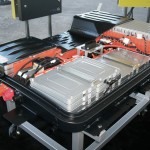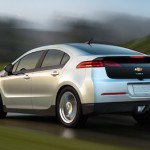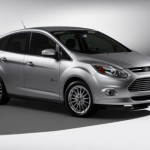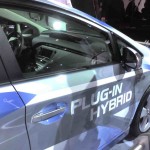By John Addison (updated 11/22/11)
Lithium batteries are everywhere. They are in your mobile phones, iPads, notebook computers, game players, music players, and a lot more. Soon lithium batteries will be in millions of hybrid and electric cars.
As electric and hybrid car competition intensifies, Nissan, GM, Toyota, and Ford are in a race to sell the most vehicles with lithium batteries. I have driven cars from each of these automakers that use lithium batteries. The cars performed beautifully and delivered great fuel economy.
Nissan will be First with 100,000 Freeway Speed Electric Cars
 Over 20,000 Nissan LEAFs have been delivered globally, putting Nissan ahead of the competition in the electric car race. My wife and I took delivery of our LEAF in late April and have enjoyed driving it ever since. Nissan backlog grows as it expands sales to more states. Nissan is currently constrained to making 50,000 LEAFs per year to by production from one plant in Japan.
Over 20,000 Nissan LEAFs have been delivered globally, putting Nissan ahead of the competition in the electric car race. My wife and I took delivery of our LEAF in late April and have enjoyed driving it ever since. Nissan backlog grows as it expands sales to more states. Nissan is currently constrained to making 50,000 LEAFs per year to by production from one plant in Japan.
Nissan will deliver 50,000 LEAFs in 2012. They heroically recovered after Japan’s tragic earthquake, tsunami, and nuclear meltdowns. As part of the Renault-Nissan alliance, the lithium battery numbers are much higher. In 2013, a new plant opens in Tennessee with the ultimate capacity of 150,000 LEAFs per year plus 200,000 lithium battery packs per year.
Nissan’s Mark Perry, Director of Product Planning, “Electrification of transportation is no longer an ‘if’ rather a when. Most manufacturers have active programs in HEV, PHEV,EV and FC. New 2025 CAFE regulations will require more advanced technology deployment to achieve 54.5 targets than today. Nissan forecasts 10% market share will be pure EV by 2020.”
The LEAF lithium-nickel-manganese polymer battery packs are produced by AESC, a joint venture of Nissan and NEC. The new Nissan hybrid system uses the same AESC li-ion design as the LEAF with fewer kilowatts being needed. By switching from NiMH batteries to li-ion, weight can be removed from the vehicle. A wider state-of-charge with lithium can also improve mileage. All 2012 Nissan hybrid cars use lithium batteries including the Altima Hybrid and the Infinity M35H.
General Motors Leads with Plug-in Hybrids
 General Motors and LG Group are jointly designing and engineering future electric vehicles, expanding a relationship built on LG’s work as the battery cell supplier for the Chevrolet Volt and Opel Ampera extended-range EVs. The GM-LG joint development will expand the number and types of electric vehicles that GM makes and sells by using LG’s proven expertise in batteries and other systems. In 2012, GM will deliver at least 60,000 Volts and Amperas with LG Chem advanced lithium battery cells.
General Motors and LG Group are jointly designing and engineering future electric vehicles, expanding a relationship built on LG’s work as the battery cell supplier for the Chevrolet Volt and Opel Ampera extended-range EVs. The GM-LG joint development will expand the number and types of electric vehicles that GM makes and sells by using LG’s proven expertise in batteries and other systems. In 2012, GM will deliver at least 60,000 Volts and Amperas with LG Chem advanced lithium battery cells.
“Many solutions for tomorrow’s transportation needs may be available more quickly by building on our partnership strategy,” said GM Vice Chairman Steve Girsky. ”Consumers benefit by getting the latest fuel-saving technology faster if we work with the best suppliers and we save time and money in the development process.”
The success of the extended-range propulsion system in the Volt and Ampera led to exploring other collaborations in the electrification of the automobile. Teams of LG and GM engineers will work on key components, as well as vehicle structures and architectures. Vehicles resulting from the partnership will be sold in many countries.
The GM-LG relationship that began with LG delivering the cells for the battery pack of the Chevrolet Volt and Opel Ampera expanded last year with work on a demonstration fleet of Chevrolet Cruze electric vehicles. These vehicles were used as official vehicles of the G20 summit in Seoul are now in the phase of market-testing to learn more about capabilities and requirements.
GM is not putting all of its eggs in one basket. The new pure-electric 2013 Chevrolet Spark EV will use A123 lithium-ion nanophosphate prismatic cells.
Ford Switching to Lithium Batteries for All Hybrids
 Ford will only use lithium batteries in all 2013 model Ford hybrids which start selling in the middle of calendar year 2012. Ford is currently second only to Toyota in global hybrid sales, thanks to vehicles like the Escape Hybrid and Fusion Hybrid.
Ford will only use lithium batteries in all 2013 model Ford hybrids which start selling in the middle of calendar year 2012. Ford is currently second only to Toyota in global hybrid sales, thanks to vehicles like the Escape Hybrid and Fusion Hybrid.
Although the Renault-Nissan Alliance is most likely to be first with 100,000 lithium-battery cars, Ford may be the first car maker to sell 100,000 cars annually that includes lithium batteries. When I lasted interviewed Nancy Gioia, Director Ford Global Electrification, she said that Ford has a 2020 goal of 10 to 25 percent of its vehicle sales including lithium batteries. Her best guess is that 70% would be hybrids, 20 to 25% plug-in hybrids, and 5 to 10% battery-electric. Everything from technology innovation to oil prices will affect the future mix.
Ford Motor is admired for refusing bailout money and returning to strong profitability. Ford’s electrification plans have the potential for better profit margins as it builds many vehicles for the global market on a common platform. For example, we will see a growing number of hybrid and electric vehicles on the C platform including the Ford Focus Electric, Transit Connect Electric, and new C-MAX Hybrid and C-MAX Energi.
With the C-MAX, we will see that Ford powersplit hybrids and blended plug-in hybrids share about 85 percent of the same components including electric traction motor, generator, inverters, DC/DC converters, electric accessories, transmission, and engine. Both the C-MAX Energi and C-MAX Hybrid models, with a common chassis, will be built alongside the all-new 2012 Ford Focus and Focus Electric at Ford’s Michigan Assembly Plant in Wayne, Mich.
Ford, however, will use different pack design and cell chemistry for its hybrids, plug-in hybrids, and battery-electric. While some of Ford’s competitors focus on joint ventures with a single battery company, Ford controls pack design and assembly. Different cell manufacturers are considered for different vehicles. Lithium cell providers include LG Chem/Compact Power (CPI) for the Ford Focus Electric and Johnson Control for the Transit Connect Electric.
Toyota’s Incremental Approach to Plug-in Hybrids and Electric Car
 Toyota Motor Corp is bringing to market four vehicles with lithium batteries – the Prius PHV, the RAV4 EV, the Scion IQ EV, and rumors of a Camry Plug-in Hybrid. These electric vehicles give Toyota a shot at selling 100,000 vehicles with lithium batteries in 2013, but Toyota is not likely to be first with 100,000. It will be Nissan, GM or Ford.
Toyota Motor Corp is bringing to market four vehicles with lithium batteries – the Prius PHV, the RAV4 EV, the Scion IQ EV, and rumors of a Camry Plug-in Hybrid. These electric vehicles give Toyota a shot at selling 100,000 vehicles with lithium batteries in 2013, but Toyota is not likely to be first with 100,000. It will be Nissan, GM or Ford.
Toyota has over 3 million hybrids on the road with NiMH batteries. Why fight success? Toyota will be careful in switching to lithium-ion. Economics, reduced vehicle weight, and more interior room will eventually make the switch compelling.
Toyota is not afraid to partner with potential competitors if it accelerates time to market for the right vehicles. Toyota, which owns 2 percent of Tesla, contracted with Tesla for lithium battery packs and drive system integration for the new Toyota RAV4 EV. Toyota has a long history with battery giants Panasonic and Sanyo. Recently, Toyota and Ford announced that they would equally collaborate in the development of advanced hybrid systems for rear-wheel drive trucks and SUVs.
Clean Fleet Report Forecasts One Million Vehicles with Lithium Batteries
Production of electrified vehicles is gearing up all over the world, and automakers are planning to launch an increasing variety of new models over the next few years. Hybrid electric vehicles (HEVs), plug-in hybrid electric vehicles (PHEVs), and battery electric vehicles (BEVs) will all share the market stage as electrified vehicles continue to capture a larger portion of the total vehicle market.
Clean Fleet Report forecasts that in 2014 over one million vehicles will be sold with lithium battery packs and electric motors as demand grows for electric cars and hybrids. With manufacturing volume and technology improvements, lithium battery pack costs continue to drop. Three years ago, automaker pack costs were around $1,000/kW. Today, they are around $500. By 2020, they could be at $250/kWh. If oil prices rise, we could see the tipping point in this decade where electric cars are less expensive than gasoline and diesel powered cars.
According to a new report from Pike Research, cumulative sales of plug-in electric vehicles (PEVs), the category that includes both PHEVs and BEVs, will reach 5.2 million units by 2017, up from just under 114,000 vehicles in 2011. By the same year, cumulative sales of HEVs will represent an additional 8.7 million vehicles, for a combined total of 13.9 million units in all electrified vehicle categories.
Energy storage is a $30 billion industry with steady growth. Michigan is now home to 17 advanced battery companies in various stages of construction and production, representing nearly $6 billion in capital investment and expected to create an estimated 20,000 new direct jobs over the next 10 years. The state is expected to make approximately 20 percent of the world’s lithium ion batteries. The Battery Show will be held October 25-27 in Novi, Michigan.
Some automakers want to be first to market with electric cars and advanced batteries; others want to be first to volume. As Nissan, GM, Toyota, Ford, and other automakers compete for hybrid and electric car leadership we will continue to see technological advancements and cost reduction in advanced batteries, electric motors, and electric drive system components. The race is on and the car driver is the sure winner.
